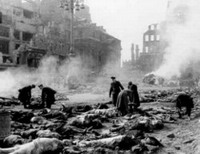World War II airmen honor European allies
Milan Buros no longer remembers the names of four U.S. airmen he led to safety in the forests of his native Slovakia in 1944, but still has their flight jacket.

Nor can he recall how many Jews he saved along similar escape routes.
But the big picture is still clear, the 82-year-old said, his ice-blue eyes dancing at the memory.
"We wanted to save our future, our lives," he said of Hitler's plan to crush his people. "We knew our fate, and that we were next on the list to be killed."
Three dozen U.S. airmen who were shot down behind enemy lines during World War II are gathering at a St. Louis hotel this week sharing stories with people like Buros. He's one of nine "helpers" being honored at the reunion of The Air Forces Escape and Evasion Society.
The society, which was founded in the 1960s, is made up of U.S. airmen who crash-landed or parachuted into German-occupied territory when their planes were shot down in the second world war. Yet, they evaded capture and returned to their units with the help of people on the ground in places like Belgium, Holland, France, Greece and the Balkans.
It would have been nearly impossible to escape without them, the men said. Many of their crew mates were executed or captured by the Nazis.
"They wanted to get the Germans the hell out of their city," said society president Richard Smith, of Battle Lake, Minnesota "They wanted to help (the airmen) fight the Germans instead of ending up in a POW camp."
Members of the French Resistance, the Dutch and Belgian underground, and partisans and soldiers from the former Yugoslavia led more than 2,000 U.S. airmen to safehouses and farms where they were kept and fed until it was safe to travel an escape route out.
Some ventured over the Pyrenees Mountains from France into the relative safety of Spain. Others were taken to makeshift airfields in rural meadows and airlifted to England.
Reunion organizer Yvonne Daley-Brusselmans, a 75-year-old "helper" from Belgium, but now living in south Florida, said there were five major escape lines.
Smith's plane was shot down over France on Dec. 30, 1943. He said he delayed pulling his parachute as long as he could to give the Germans less time to react to seeing - and capturing - him.
He ended up 50 miles (80 kilometers) north of Paris, and hid in a hedge row before three Frenchmen found him and got him in the trunk of their vehicle. They drove him 25 minutes to an abandoned farmhouse, where he was met by his radio operator and co-pilot.
The three later stayed with a couple and their baby, "who gave us their bed and fed us lots of rabbit stew," he said.
Marguerite Brouard-Miller, 79, now of Sedona, Arizona, was a teenager in 1943 when a family friend asked her mother to house airmen in her Paris apartment. They kept two at a time for three weeks, helping 17 U.S. airmen and a British spy in all.
They walked them to a station, where they would catch a train and be met by a guide who would take them across the Pyrenees. "They all arrived safely, and my mother kept in touch with them," she said. "But after a while, you lose touch, and quite a few are deceased."
Peter Hakim, now 81 and residing in Livingston, New Jersey, said being part of the Belgian underground was an adventure when he was 18.
But his parents, who had seven children, took a huge risk, he said.
They helped hide 10 airmen whose B-17 crash landed near their home in May 1944, and kept them safe for six months. They didn't exchange names, he said. Word might get out and someone might betray them.
"If you were found out, the Germans had no pity," Hakim said.
"The man would be shot and the women and children would go to a concentration camp. You could be arrested for possessing a radio. My father hid one in the hay loft so he could go to the barn at night and listen to the BBC."
Subscribe to Pravda.Ru Telegram channel, Facebook, RSS!




